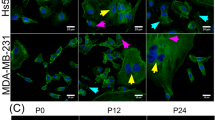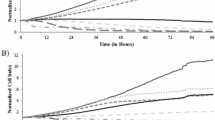Abstract
This study was designed to investigate the molecular changes that may develop during exposure of breast cancer cells to anticancer agents and that may lead to acquired resistance. We used two breast cancer cell lines, a parental (MCF7/WT) and a doxorubicin-resistant (MCF7/DOX) one. Cell survival, cell cycle distribution and RT-PCR expression level of genes involved in DNA damage response, MDR1, GST and TOPOIIα were measured. MCF7/DOX cells were five-fold more resistant to doxorubicin (DOX) than the MCF7/WT cells. DOX treatment causes arrest of MCF7/DOX cells in G1 and G2 phases of cell cycle whereas MCF7/WT cells were arrested in S-phase. The molecular changes in both cell lines due to DOX treatment could be classified into: (1) the basal level of p53, p21, BRCA1, GST and TOPOIIα mRNA was higher in MCF7/DOX than MCF7/WT. During DOX treatment, the expression level of these genes decreased in both cell lines but the rate of down-regulation was faster in MCF7/WT than MCF7/DOX cells. (2) The expression level of MDR1 was the same in both cell lines but 48 and 72 h of drug treatment, MDR1 disappeared in MCF7/WT but still expressed in MCF7/DOX. (3) There was no change in the expression level of BAX, FAS and BRCA2 in both cell lines. Conclusively, after validation in clinical samples, overexpression of genes like BRCA1, p53, p21, GST, MDR1 and TOPOIIα could be used as a prognostic biomarker for detection of acquired resistance in breast cancer and as therapeutic targets for the improvement of breast cancer treatment strategies.





Similar content being viewed by others
References
Mauri, D., Pavlidis, N., & Ioannidis, J. (2005). Neoadjuvant versus adjuvant systemic treatment in breast cancer: A meta-analysis. Journal of the National Cancer Institute, 97, 188–194.
Campos, S. (2003). Liposomal anthracyclines: Adjuvant and neoadjuvant therapy for breast cancer. Oncologist, 8, 10–16.
Bartek, J., & Jiri Lukas, J. (2007). DNA damage checkpoints: From initiation to recovery or adaptation. Current Opinion in Cell Biology, 19, 238–245.
Lukas, J., Lukas, C., & Bartek, J. (2004). Mammalian cell cycle checkpoints: Signalling pathways and their organization in space and time. DNA Repair, 3, 3997–4007.
Bartek, J., & Lukas, J. (2003). Chk1 and Chk2 kinases in checkpoint control and cancer. Cancer Cell, 3, 421–429.
Bartek, J., Bartkova, J., & Lukas, J. (2007). DNA damage signaling guards against activated oncogenes and tumour progression. Oncogene, 26, 7773–7779.
Tewari, K., & Manetta, A. (1999). In vitro chemosensitivity testing and mechanisms of drug resistance. Current Oncology Reports, 1, 77–84.
Teodori, E., Dei, S., Scapecchi, S., & Gualtieri, F. (2002). The medicinal chemistry of multidrug resistance (MDR) reversing drugs. Farmaco, 57, 385–415.
Goto, S., Ihara, Y., Urata, Y., Izumi, S., Abe, K., Koji, T., et al. (2002). Doxorubicin-induced DNA intercalation and scavenging by nuclear glutathione S-transferase π. FASEB Journal, 15, 2702–2714.
Schneider, E., Horton, J., Yang, C., Nakagawa, M., & Cowan, K. (1994). Multi-drug resistance associated protein gene over-expression and reduced drug sensitivity of topoisomerase II in a human breast carcinoma MCF7 cell line selected for etoposide resistance. Cancer Research, 54, 152–158.
Azab, S., El-Demerdash, E., Abdel-Naim, A., Youssef, E., El-Sharkawy, N., & Osman, A. (2005). Modulation of epirubicin cytotoxicity by tamoxifen in human breast cancer cell lines. Biochemical Pharmacology, 70, 725–732.
Li, J., Xu, L., He, K., Guo, W., Zheng, Y., Xia, P., et al. (2001). Reversal effects of nomegestrol acetate on multi-drug resistance in adriamycin-resistant MCF-7 breast cancer cell line. Breast Cancer Research, 3, 253–263.
Gewirtz, D. A. (1999). A critical evaluation of the mechanisms of action proposed for the antitumor effects of the anthracycline antibiotics adriamycin and daunorubicin. Biochemical Pharmacology, 57, 727–741.
Sherr, C., & Roberts, J. (1999). CDK inhibitors: Positive and negative regulators of G1-phase progression. Genes and Development, 13, 1501–1512.
Taylor, W., & Stark, G. (2001). Regulation of the G2/M transition by p53. Oncogene, 20, 1803–1815.
Bucher, N., & Britten, C. (2008). G2 checkpoint abrogation and checkpoint kinase-1 targeting in the treatment of cancer. British Journal of Cancer, 98, 523–528.
Wendt, J., Radetzki, S., Von Haefen, C., Hemmati, P., Güner, D., Schulze-Osthoff, K. B., et al. (2006). Induction of p21CIP/WAF-1 and G2 arrest by ionizing irradiation impedes caspase-3-mediated apoptosis in human carcinoma cells. Oncogene, 25, 972–980.
Iwamoto, K., Shinomiya, N., & Mochizuki, H. (1999). Different cell cycle mechanisms between UV-induced and X-ray-induced apoptosis in WiDr colorectal carcinoma cells. Apoptosis, 4, 59–66.
Rigberg, D., Blinman, T., Kimf, S., Colem, A., & Mcfaddend, W. (1999). Antisense blockade of p21/WAF1 decreases radiation-induced G2 arrest in esophageal squamous cell carcinoma. The Journal of Surgical Research, 81, 6–10.
Bunz, F., Dutriaux, A., Lengauer, C., Waldman, T., Zhou, S., Brown, J., et al. (1998). Requirement for p53 and p21 to sustain G2 arrest after DNA damage. Science, 282, 1497–1501.
Lajeski, A., Phan, V., Kottke, T., & Kaufmann, S. (2002). G1 and G2 cell-cycle arrest following microtubule depolymerization in human breast cancer cells. Journal of Clinical Investigation, 110, 91–99.
Hohenstein, P., & Giles, R. (2003). BRCA1: A scaffold for p53 response? Trends in Genetics, 19, 489–494.
Maclachlan, T. K., Takimoto, R., & El-Deiry, W. S. (2002). BRCA1 directs a selective p53-dependent transcriptional response towards growth arrest and DNA repair targets. Molecular and Cellular Biology, 22, 4280–4292.
Arizti, P., Fang, L., Park, I., Yin, Y., Solomon, E., Ouchi, T., et al. (2000). Tumor suppressor p53 is required to modulate BRCA1 expression. Molecular and Cellular Biology, 20, 7450–7459.
Castedo, M., Perfettini, J., Roumier, T., Andreau, K., Medema, R., & Kroemer, G. (2004). Cell death by mitotic catastrophe: A molecular definition. Oncogene, 23, 2825–2837.
Castedo, M., & Kroemer, G. (2004). Mitotic catastrophe: A special case of apoptosis. Journal de la Société de biologie, 198, 97–103.
Roninson, I. B., Broude, E. V., & Chang, B. (2001). If not apoptosis, then what? Treatment-induced senescence and mitotic catastrophe in tumour cells. Drug Resistance Updates, 4, 303–313.
Schmitt, C., Fridman, J., Lee, Y., Baranov, E., Hoffman, R., & Lowe, S. (2002). A senescence program controlled by p53 and p16INK4a contributes to the outcome of cancer therapy. Cell, 109, 335–346.
Eom, Y., & Choi, K. (2007). Bcl-xL blocks high dose doxorubicin-induced apoptosis but not low dose doxorubicin-induced cell death through mitotic catastrophe. Biochemical and Biophysical Research Communications, 363, 1044–1049.
Park, S., Eom, Y., & Choi, K. (2005). Cdc2 and Cdk2 play critical roles in low dose doxorubicin-induced cell death through mitotic catastrophe but not in high dose doxorubicin-induced apoptosis. Biochemical and Biophysical Research Communications, 334, 1014–1021.
Cheng Lin, Y., & Fang Wang, F. (2008). Mechanisms underlying the pro-survival pathway of p53 in suppressing mitotic death induced by adriamycin. Cellular Signaling, 20, 258–267.
De Bruin, E., & Medema, J. (2008). Apoptosis and non-apoptotic deaths in cancer development and treatment response. Cancer Treatment Reviews, 34, 737–749.
Eom, Y., Kim, M., Park, S., Goo, M., Kwon, H., Seonghyang, S., et al. (2005). Two distinct modes of cell death induced by doxorubicin: Apoptosis and cell death through mitotic catastrophe accompanied by senescence-like phenotype. Oncogene, 24, 4765–4777.
Di Leo, A., Biganzoli, L., Claudino, W., Licitra, S., Pestrin, M., & Larsimont, D. (2008). Topoisomerase II alpha gene as a marker predicting anthracyclines activity in early breast cancer patients: Ready for the primetime? European Journal of Cancer, 44, 2791–2798.
Pritchard, K., Messersmith, H., Elavathi, L., Trudeau, M., Malley, F., & Dhesy-Thind, B. (2008). HER-2 and Topoisomerase II as predictors of response to chemotherapy. Journal of Clinical Oncology, 26, 736–744.
Malley, F., Chia, S., Tu, D., Shepherd, L., Levine, M., Huntsman, D., et al. (2006). Prognostic and predictive value of topoisomerase II Alpha in a randomized trial comparing CMF to CEF in premenopausal women with node positive breast cancer. ASCO Annual Meeting Proceedings. Journal of Clinical Oncology, 24, 533 (abstract).
Durbecq, V., Paesmans, M., Cardoso, F., Desmedt, C., Di Leo, A., Chan, S., et al. (2004). Topoisomerase II alpha as a predictive marker in a population of advanced breast cancer patients randomly treated either with single-agent doxorubicin or single-agent docetaxel. Molecular Cancer Therapeutics, 3, 1207–1214.
Fritz, P., Cabrera, C., Dippon, J., Gerteis, A., Simon, W., Aulitzky, W., et al. (2005). C-erbB2 and topoisomerase IIα protein expression independently predict poor survival in primary human breast cancer: A retrospective study. Breast Cancer Research, 7, 374–384.
Nagane, M., Asai, A., Shibuui, S., Oyama, H., Nomura, K., & Kuchino, Y. (2008). Expression pattern of chemoresistance-related genes in human malignant brain tumors: A working knowledge for proper selection of anticancer drugs. Japanese Journal of Clinical Oncology, 29, 527–534.
Burg, D., Riepsaame, J., Pont, C., Mulder, G., & van de Water, B. (2006). Peptide-bond modified glutathione conjugate analogs modulate GSTpi function in GSH-conjugation, drug sensitivity and JNK signaling. Biochemical Pharmacology, 71, 268–277.
Huang, J., Tan, P., Thiyagarajan, J., & Bay, B. (2003). Prognostic significance of glutathione S-transferase-pi in invasive breast cancer. Modern Pathology, 16, 558–565.
Györffy, B., Serra, V., Jürchott, K., Abdul-Ghani, R., Garber, M., Stein, U., et al. (2005). Prediction of doxorubicin sensitivity in breast tumors based on gene expression profiles of drug-resistant cell lines correlates with patient survival. Oncogene, 24(51), 7542–7551.
Stigbrand, R. (2004). Interfering with cancer: A brief outline of advances in RNA interference in oncology. Tumor Biology, 25, 329–336.
Wu, H., Hait, W. N., & Yang, J. M. (2003). Small interfering RNA-induced suppression of MDR1 (P-glycoprotein) restores sensitivity to multidrug-resistant cancer cells. Cancer Research, 63(7), 1515–1519.
Paull, A., & Whikehart, D. (2005). Expression of the p53 family of proteins in central and peripheral human corneal endothelial cells. Molecular Vision, 11, 328–334.
Burns, T., Bernhard, E., & El-Deiry, W. (2001). Tissue specific expression of p53 target genes suggests a key role for killer/DR5 in p53 dependent apoptosis in vivo. Oncogene, 20, 4601–4612.
Andres, J., Fan, S., Turkel, G., Wang, J., Twu, N., Yuan, R., et al. (1998). Regulation of BRCA1 and BRCA2 expression in human breast cancer cells by DNA-damaging agents. Oncogene, 16(17), 2229–2241.
Acknowledgment
This work was supported by National Cancer Institute project grant, Cairo University, Egypt.
Author information
Authors and Affiliations
Corresponding author
Rights and permissions
About this article
Cite this article
Saleh, E.M., El-Awady, R.A., Abdel Alim, M.A. et al. Altered Expression of Proliferation-Inducing and Proliferation-Inhibiting Genes Might Contribute to Acquired Doxorubicin Resistance in Breast Cancer Cells. Cell Biochem Biophys 55, 95–105 (2009). https://doi.org/10.1007/s12013-009-9058-3
Received:
Accepted:
Published:
Issue Date:
DOI: https://doi.org/10.1007/s12013-009-9058-3




